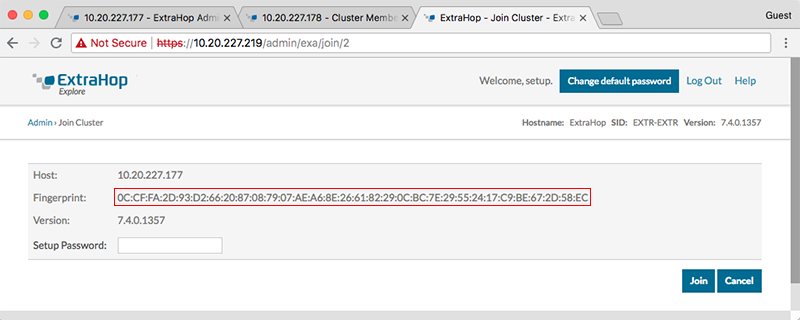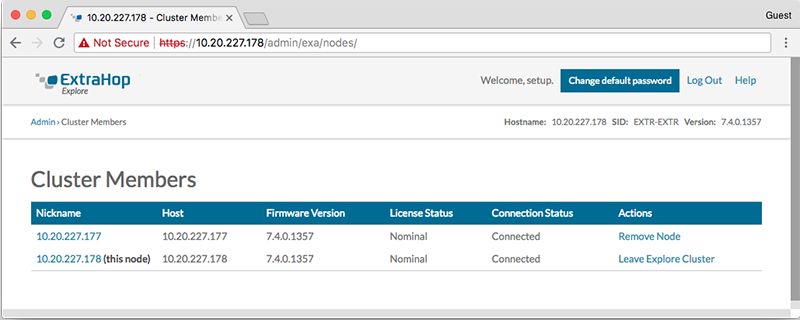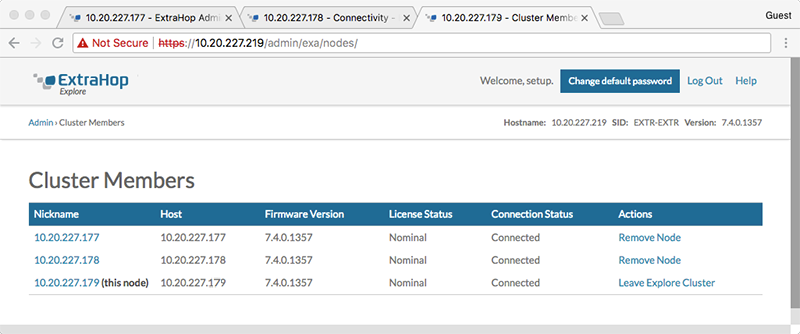Deploy the ExtraHop Explore Appliance with VMware
In this guide, you will learn how to deploy the ExtraHop Explore virtual appliance with the vSphere client running on a Windows machine and to join multiple Explore appliances to create an Explore cluster. You should be familiar with administering VMware ESX and ESXi environments before proceeding.
The Explore virtual appliance is distributed as an OVA package that includes a preconfigured virtual machine (VM) with a 64-bit, Linux-based OS that is optimized to work with VMware ESX and ESXi version 5.5 and later.
| Important: | If you want to deploy more than one ExtraHop virtual sensor, create the new instance with the original deployment package or clone an existing instance that has never been started. |
System requirements
Your environment must meet the following requirements to deploy a virtual Explore appliance:
| Important: | ExtraHop tests virtual clusters on local storage for optimal performance. ExtraHop strongly recommends deploying virtual clusters on continuously available, low latency storage, such as a local disk, direct-attached storage (DAS), network-attached storage (NAS), or storage area network (SAN). |
- An existing installation of VMware ESX or ESXi server version 5.5 or later capable of
hosting the Explore virtual appliance. The Explore virtual appliance is available in the
following configurations:
EXA Manager Node EXA-XS EXA-S EXA-M EXA-L 4 CPUs 4 CPUs 8 CPUs 16 CPUs 32 CPUs 8 GB RAM 8 GB RAM 16 GB RAM 32 GB RAM 64 GB RAM 4 GB boot disk 4 GB boot disk 4 GB boot disk 4 GB boot disk 4 GB boot disk 12 GB 250 GB or smaller datastore disk 500 GB or smaller datastore disk 1 TB or smaller datastore disk 2 TB or smaller datastore disk The hypervisor CPU should provide Supplemental Streaming SIMD Extensions 3 (SSSE3) support.
Note: The EXA manager node is preconfigured with a 12 GB datastore disk. You must manually configure a second virtual disk to the other EXA configurations to store record data. Consult with your ExtraHop sales representative or Technical Support to determine the datastore disk size that is best for your needs.
- A vSphere client
- An Explore virtual appliance license key.
- The following TCP ports must be open:
- TCP ports 80 and 443: Enables you to administer the Explore appliance. Requests sent to port 80 are automatically redirected to HTTPS port 443.
- TCP port 9443: Enables Explore nodes to communicate with other Explore nodes in the same cluster.
Deploy the Explore virtual appliance
Before you begin
If you have not already done so, download the ExtraHop Explore virtual appliance OVA file for VMware from the ExtraHop Customer Portal.| Note: | If you must migrate the VM to a different host after deployment, shut down the virtual appliance first and then migrate with a tool such as VMware VMotion. Live migration is not supported. |
Configure a static IP address through the CLI
The ExtraHop system is configured by default with DHCP enabled. If your network does not support DHCP, no IP address is acquired, and you must configure a static address manually.
| Important: | For deployments that include a sensor that is connected to an ECA VM console, we strongly recommend configuring a unique hostname. If the IP address on the sensor is changed, the console can re-establish connection easily to the sensor by hostname. |
- Access the CLI through an SSH connection, by connecting a USB keyboard and SVGA monitor to the physical ExtraHop appliance, or through an RS-232 serial (null modem) cable and a terminal emulator program. Set the terminal emulator to 115200 baud with 8 data bits, no parity, 1 stop bit (8N1), and hardware flow control disabled.
- At the login prompt, type shell and then press ENTER.
- At the password prompt, type default, and then press ENTER.
-
To configure the static IP address, run the following commands:
Configure the recordstore
After you obtain the IP address for the recordstore, log in through https://<explore_ip_address>/admin and complete the following recommended procedures.
| Note: | The default login username is setup and the password is default. |
- Register your ExtraHop system
- Connect the console and sensors to ExtraHop recordstores
- Send record data to the Explore appliance
- Review the Explore Post-deployment Checklist and configure additional recordstore settings.
Create a recordstore cluster
For the best performance, data redundancy, and stability, you must configure at least three recordstores in a cluster.
| Important: | If you are creating a recordstore cluster with six or more nodes, you must configure the cluster with manager nodes. For manager node instructions, see Deploying manager nodes. |
In the following example, the recordstores have the following IP addresses:
- Node 1: 10.20.227.177
- Node 2: 10.20.227.178
- Node 3: 10.20.227.179
You will join nodes 2 and 3 to node 1 to create the recordstore cluster. All three nodes are data nodes. You cannot join a data node to a manager node or join a manager node to a data node to create a cluster.
| Important: | Each node that you join must have the same configuration (physical or virtual) and the same ExtraHop firmware version. EXA 5100 and EXA 5200 physical recordstores can be in the same cluster. |
Before you begin
You must have already installed or provisioned the recordstores in your environment before proceeding.Connect the recordstore to a console and all sensors
After you deploy the recordstore, you must establish a connection from the console and all sensors before you can query records.
| Important: | Connect the sensor to each recordstore node so that the sensor can distribute the workload across the entire recordstore cluster. |
| Note: | If you manage all of your sensors from a console, you only need to perform this procedure from the console. |
- Log in to the Administration settings on the ExtraHop system through https://<extrahop-hostname-or-IP-address>/admin.
- In the ExtraHop Recordstore Settings section, click Connect Recordstore.
- Click Add New.
- In the Node 1 section, type the hostname or IP address of any recordstore in the cluster.
- For each additional node in the cluster, click Add New and enter the individual hostname or IP address for the node.
- Click Save.
- Confirm that the fingerprint on this page matches the fingerprint of node 1 of the recordstore cluster.
- In the Explore Setup Password field, type the password for the node 1 setup user account and then click Connect.
- When the Explore Cluster settings are saved, click Done.
Send record data to the recordstore
After your recordstore is connected to your console and sensors, you must configure the type of records you want to store.



Thank you for your feedback. Can we contact you to ask follow up questions?